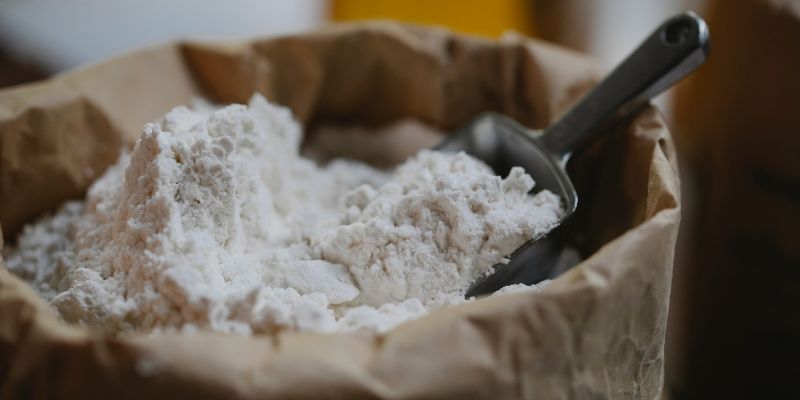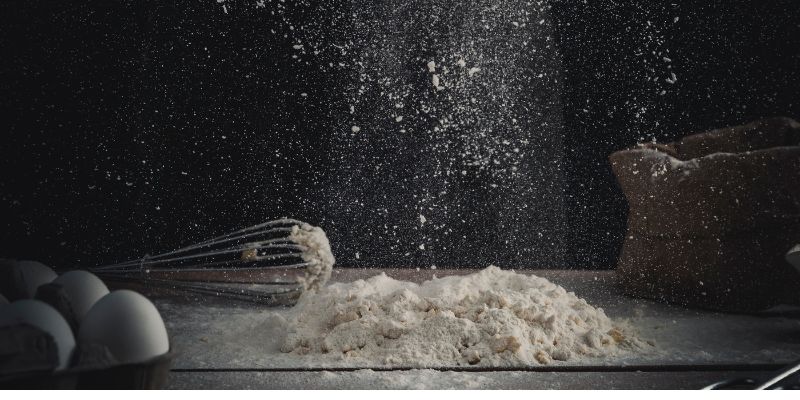What's the Difference Between Bread Flour and All-Purpose Flour: An Overview
Sep 03, 2023 By Cassandra Bailey
Compared to bread flour, what features distinguish all-purpose flour, protein, in this scenario, is the ruler. Baked products rely on gluten for their structure, and the protein content affects gluten formation.
Both forms of flour come from grinding grains, and while whole-grain bread flour is typically called for in recipes, white flour is often seen in stores. Here's why even a slight change in protein content matters.

All-Purpose Flour
Cookies, pastries, cakes, muffins, quick bread, and many more are made with all-purpose flour since it is the most versatile. You probably predicted well that it has infinite applications or at least a large subset.
All-purpose flour, which provides between 8 and 11 percent protein according to the Wheat Foods Council, is great for cakes, cookies, and other baked products that don't require the same density or structural strength as bread. Here's something to consider when deciding between all-purpose flour and bread flour.
While all-purpose flour is more extensively used and readily available than specialty flours, its quality can vary greatly, which may impact how it performs in certain recipes. So, if you're making your tried-and-true blueberry muffins, but they just aren't turning out properly with the store-brand all-purpose flour, you might want to try something else.
Bread Flour
Bread flour was created specifically for baking bread, as its name suggests. Its high protein content and subsequent effects on the final product account for this. The Wheat Foods Council states that bread flour normally contains between 12 and 14 percent protein.
Why is that more relevant when baking bread than when preparing, say, cookies? For bread to turn out properly, it must be allowed to rise before baking. Bread gets its characteristic dense, thick, and soft feel from the protein in the flour, which, together with the gluten and the yeast, gives structure on the chemical level.
To sum up, if you want to bake a loaf of bread worthy of being sliced, toasted, and spread with jam or jelly, you must use bread flour rather than all-purpose flour.

Bread Flour Vs. All-Purpose Flour: When To Use Them
Bread flour is especially developed for bread, pizza dough, bagels, and other yeast-based dishes. For a well-risen, chewy, elastic result, its greater protein content is essential for supporting the fermentation process. To be employed in a wider variety of baked goods, all-purpose flour lives up to its name.
You may use it to make a wide variety of sweet and savory treats, including cakes, cookies, muffins, and quick bread. Bread and all-purpose flour have distinct purposes, but they may often be swapped out for one another with successful results. The final baked items may not be the same if the texture and structure are altered due to the replacement.
Some recipes call for bread flour, while others call for all-purpose flour; using all-purpose flour instead of bread flour might result in a heavier texture. The most consistent results may be achieved using the specified flour type in a recipe.
What Is The Significance Of Protein Content?
Wheat's protein composition changes based on several factors, including the variety, the growing season, and the wheat berry's color. Cake and pastry flour are often made from soft wheat because of their lower protein level (around 7–9%).
Regarding protein content, hard wheats like hard red spring and hard red winter are great for making all-purpose flour and bread flour. An important component in flour's baking performance is the amount of protein it contains.
For one instance, flour's protein content dictates how elastic its gluten will be: Cookies, cakes, and flaky pie crusts benefit from the softer texture that lower protein flours provide, whereas bread made from higher protein wheat benefits from more structure and elasticity.
Using The Bread Flour Instead Of All-Purpose Flour: An Overview
If you're looking for the answer to whether or not you can substitute bread flour for all-purpose flour or vice versa, here it is! There may be little variations in texture and flavor, but your baked items will still turn out fantastic overall.
Whatever you're baking, from pancakes to muffins to bread to cookies, the outcome will vary depending on your preferences. Both types of flour can be used in place of the one specified in the recipe, although the latter usually yields superior results.
Some recipes were developed with a particular flour in mind because of differences in ingredients, cooking times, and other factors. For this reason, baking success is usually achieved using the specified flour. But if you've already begun baking your favorite whole-wheat banana bread and are out of all-purpose flour, don't worry; bread flour is a fine substitute.
Bread Flour Vs. All-Purpose Flour
There are significant variations between bread flour and all-purpose flour, particularly in protein and gluten levels. Bread flour is ideal for a light, chewy, time-to-rise bread due to its increased protein and gluten content.
Cookies and cakes that don't require rising work well with all-purpose flour because of its reduced protein level. The main differences between the two are here. Bread flour's increased protein content (about 13 percent more) gives the dough stability, form, and rise, so the baked good maintains its shape better.
All-purpose flour is ideal for creating cookies, cakes, and other baked products since it has a lower protein content, resulting in lighter, shorter loaves. The percentage of gluten in all-purpose flour is much smaller than in bread flour. Bread flour produces fluffy, chewy bread rather than thick bread because of its increased gluten concentration.
Conclusion:
You can use all-purpose flour for almost every baking you can imagine. Please pay close attention while kneading, stretching, and folding bread dough to strengthen it sufficiently. Tender pastries are best made using all-purpose flour. However, bread flour can be used in high-fat roux and crumble tops when gluten formation is not an issue.
-
 Sep 02, 2023
Sep 02, 2023Stir-fried cucumbers and Torch Hei with Trumpet Mushrooms
Looking for a tasty, unique recipe? We recommend Stir-Fried Cucumbers with Trumpet Mushrooms and Torch Hei. This dish's exquisite flavour and texture combination will make a lasting impression. Try it, and you'll keep thinking about it!
-
 Sep 03, 2023
Sep 03, 2023For Better Grilled Vegetables, Use Your Chimney Starter: Reasons you need to know
Never use a chimney starter on solid ground. The chimney's heat might set off an explosion in the concrete, destroying the surface and perhaps injuring anybody nearby
-
 Feb 13, 2023
Feb 13, 2023Everything You Should Know About Bottled Salad Dressings
Bottled salad dressings are a great way to increase your vegetable consumption in 2023. They’re convenient, time-saving, and a delicious way to make veggies taste amazing. So, next time you’re looking to add more veggies to your diet, consider incorporating one of these delicious bottled salad dressings into your routine
-
 Sep 01, 2023
Sep 01, 2023Creamy and Cheesy Boursin Baked TikTok Pasta Recipe
This easy 30-minute Baked Boursin TikTok Pasta recipe transforms penne with creamy garlic and herb Boursin cheese sauce you'll want to eat repeatedly.
